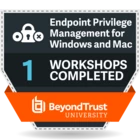Recently I began a to take a journey to leverage EPM as a logging method for those pesky “Workstation Admin Exceptions” for users who feel EPM agent gets in their way while doing work.
Essentially, I have a policy that has everything set to Passive so that EPM can detect the elevations and log them for me, but not affect the end user’s ability to “Run as Administrator”.
I am curious if anyone else has done something like this as well, and if I am going down the track.
I still have a few things to cover, but I wanted to get a feel what others have done to capture those delicate metrics to needed.






